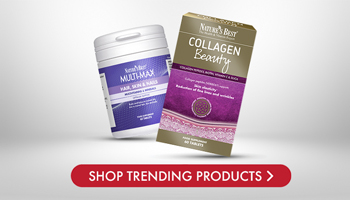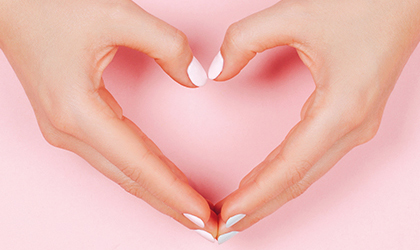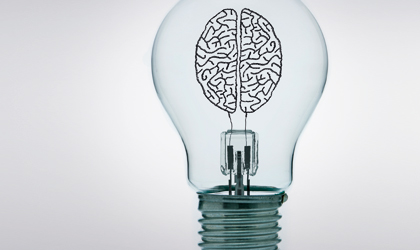
A vehicle for polish and a means of adornment, nails are one of your best beauty accessories. But how much do you really know about your nails? Here are some fun titbits of talon trivia for you.
Nails and hair are made of similar components
Nails are made of several layers of hard keratin – similar to hair. Your skin contains a thin layer of keratin too, with the thickest on your palms and soles. But what’s the difference between hair, nails, and skin? Your hair and nails contain more of the amino acid cysteine than the soft keratins of the skin. What’s more, nails have a lower fat and water content, and the skin regularly sheds its outer layer of keratin, while nails don’t.
Nails grow faster in your dominant hand
If you’re right-handed, have you ever noticed that you need to trim your nails on your right hand more often? This is because nails on your dominant hand are used more frequently and thus exposed more to the elements, which helps them to grow faster.
They also grow faster in warmer climates
People who live in sunnier climates tend to have nails that grow faster, so an exotic holiday might be just in order to get your nails growing! The sun helps your body create vitamin D – a nutrient your nails eagerly lap up to grow faster.
Water is essential for healthy nails
Your nails are little windows into your overall health, and dry, brittle nails may signal dehydration. That’s why it’s so important to stay hydrated – we’re talking about drinking at least 8-10 glasses of H20 per day. Water really is the secret to beauty, isn’t it?
Men’s nails grow faster than women’s nails
Strange, but true. The only possible exemption to this rule is when women are pregnant, as their nails tend to grow at a fast rate. That said, during the summer months, everyone’s nails grow more rapidly regardless of gender.
Typing is good for your nails
Lightly tapping away on your keyboard can, in fact, stimulate nail growth. Amazing, right?
Nail Myths Debunked
We’ve all heard the old wives tales about our fingertips, haven’t we? White marks signal a calcium deficiency, and ice-cold water dries polish faster. Yep, we know them all. Oh, and don’t even get us started on the far-fetched claims concerning the best foods, supplements and creams to transform unkempt fingertips into sleek, elegant nails. Considering nails are such a small part of the body, there’s so much to be said about them. But how much of it really holds up? Let’s find out.
Gelatine, in any form, can strengthen nails and help them grow..... FALSE! Nails are made up of the protein keratin, which may explain the common misconception that taking gelatine (another protein) could strengthen them. However, there’s no substantiating scientific evidence to support this claim. The same goes for topically applying gelatine to your nails – it just won’t work. Sorry!
White spots indicate a calcium deficiency..... FALSE! You’ll be glad to hear these strange white dots have nothing to do with a calcium deficiency. Reassuringly, these marks are simply the result of injury – that’s all! They are very common and will disappear when the nails grow.
Nails can ‘breathe’, so you don’t need to take a break from polish..... FALSE! While your nails receive oxygen and nutrients via blood flow – not ambient air, this doesn’t give you permission to wear polish 24/7. It just means that oxygen deprivation isn’t the cause of your peeling, cracking and splitting. When varnish is left on the nails for a prolonged amount of time (especially on your toenails) keratin granulation can develop, leading to white, rough patches forming on the nail. The solution: take a nail varnish holiday and keep your nails polish-free for a week or so every month.
Cold water dries nail polish faster..... FALSE! Rumour has it that plunging your freshly manicured nails into cold-water helps polish dry faster. Sound too good to be true? Well, that’s because it is. Getting varnish to properly dry requires the evaporation of solvents – and this can’t happen when your nails are submerged in water (duh!) Besides, if this water hack really did the job, why isn’t it used in nail bars?
UV gels are better than acrylics..... FALSE! No matter how much your nail technician tries to convince you that UV gels are better than acrylics, this just isn’t true. Yes – acrylics can damage your nail bed, and lead to infection, white spots and ridged nails. But gels are just as harmful. Setting your fingertips under UV light exposes the skin to risks, while soaking them in potent chemicals can impair the cuticles and nail bed
Fingertip fixes
Do you take great pride in your sleek, well-manicured nails? Or, does the daily wrath of housework, gardening and worse – your teeth, leave your fingertips more broken than beautified? Whether you style them, file them, gnaw them, or peel them, your nails go through it all. And even if you’ve ditched the gel, taken a much-needed break from the acrylic, and finally invested in that foul-tasting anti-biting polish, they can still be brittle, weak and flaky. Frustrated? We feel for you. So in a bid to help your nails grow longer, stronger and healthier, feast your eyes (and your fingers and toes) on these health hacks that are worth weaving into your nail care routine. Remember, the secret to fabulous fingertips is all in the detail; you need to look beneath the cracks, the chips and the layers of varnish.
File and style
How many times have you whipped out a file and ferociously sawed your nails back and forth? Well, contrary to popular belief, this is a big no-no. Not only does this aggressive action traumatise your nails, but it can also lead to peeling and premature breakage. So whether you’re going for an oval, square or stiletto look, the best way to file your fingertips is to work in one direction with the grain of your nail.
Cuticle care
Cuticle oil is a bit of an umbrella term. Typically, it contains a blend of vitamin E, avocado oil, jojoba oil, grapeseed oil, almond oil, coconut oil…you get the point. But while the ingredients vary, its purpose does not. This ultra-nourishing serum is designed to protect the skin around the nail, improve growth, and keep your nails looking beautiful for longer. It’s not enough to leave your fingertips to fend for themselves between manicures. You need to show them some TLC every day. If you have parched cuticles they won’t stand a chance against our lightweight, velvety Grapeseed oil. Extracted from grape seeds, this nutrient powerhouse is rich in essential minerals which are highly moisturising and nourishing for caressing your cuticles.
Trim often
You know the drill with your hair, right? Regular trims = luscious locks. Well, it’s no different when it comes to your digits. Set aside time to clip them every fortnight, adjusting this window to more or less often once you see how well your nails respond.
Cuticles: to cut or not to cut?
This is another myth we need to dispel. Cutting your cuticles is absolute blasphemy in the nail world. Your cuticles serve an important purpose because they seal the area at the base of your nails. So when you remove them, you break this vital means of protection and leave your nails open to all sorts of infections. The more you leave your cuticles alone, the more your nails will thank you. And if a nail technician goes anywhere near them, you have our permission to swat them away!
Be gentle
Your nails are delicate – respect their fragility. And try not to be so heavy handed when tidying them up. Did you know that roughly scrubbing your fingertips could actually leave you vulnerable to infection? Oh, and another no-no is using metal tools under the nail. Digging, picking and scrapping under the nail plate can cause it to separate from the skin, which could lead to an irregular white arching nail tip and no one wants that, do they?
Do’s and Don’ts of Nail Care
Follow these golden rules for flawless fingertips, forever…
Do:
Wear gloves
When you’re washing the dishes, using potent cleaning products, or de-weeding your garden, wear gloves! Seriously, there’s no excuse not to. Gloves will protect your fingertips from the general wear and tear that comes with these activities.
Disinfect cuts or tears on the cuticle
Not only do cuts and tears around the nail look unsightly, but they can actually cause long-term damage to the nail. Whenever you get an injury, disinfect it immediately with antibacterial ointment or our go-to favourite: Tea-Tree Oil.
Get manicures
Experts are onto something when they suggest a weekly manicure is the secret to nourished digits. Grooming your nails regularly will ensure your polish, shape, length and cuticle health is always on point. Plus, it’s a great excuse to squeeze in some self-care, which we all need a little more of, right? …but check out your salon Yes – get manicures, but don’t forget to check out your salon too. Did you know the most common infection acquired from nail salons is warts? Yuck. To protect yourself from critters, ensure your nail technician works at an establishment that is clean, sterile and fully licensed.
Take care of your tools
Cleaning your nail tools is just as important as disinfecting your makeup brushes. Why? One word: bacteria. To keep your fingertips infection-free, wash your metal tools with soap and water, and then rub with alcohol. Also, don’t forget to replace your nail files regularly. Honestly, there’s no reason to continue using tattered tools when they are so simple and inexpensive to replace.
Don’t:
Soak nails for long periods
A long, hot bath can be just what the doctor ordered in moments of stress, but soaking your hands for extended periods of time can lead to your nails becoming saturated with water and weaken. By all means, enjoy your time in the tub, but occupy your hands with a novel or more of our educational literature!
Pull off hangnails
Sure, your hanging nail is just begging to be torn off, but resist the urge. Pulling your fingernails can rip along the live tissue, exposing them to all sorts of nasty fungi and bacteria. Eek!
Overuse hand sanitizer
The alcohol found in many hand sanitizers can dehydrate your cuticles, so it’s wise to opt for an alcohol-free one if possible.
Share your nail file
Bacteria and other nasty critters nest on nail files, so using your pal’s tools is a sure-fire way to transfer their microbes from the file to your body. Bottom line: always keep your emery boards to yourself.
Use nails as tools
OK. We’ll hand it to you (quite literally). This can be difficult to resist at times. Why would you reach for a pair of scissors when your fingernails do an excellent job of opening up that box or letter? But all this picking, prying and poking can damage your digits and cut your cuticles. So make a conscious effort to think about how you use your nails. Remember, they aren’t handy knives, scissors or cutters.
Choose Collagen Beauty to support nail health
Our collagen supplement, Collagen Beauty, utilises the patented VERISOL® bioactive collagen peptides, with type I and III peptide profiles. Type I collagen is primarily found in hair, skin, and nails, while type III collagen is found in arteries, muscles, and connective tissue. This unique formulation provides hydrolysed collagen for improved absorption. This is because it has undergone enzymatic hydrolysis, a process that breaks down the peptides into shorter, more easily absorbed protein chains.
Clinical studies using VERISOL® bioactive collagen peptides have demonstrated that taking 2.5g of VERISOL® bioactive collagen daily over a period of 24 weeks significantly improved nail appearance. The studies found a 12% increase in nail growth, a 42% decrease in the frequency of broken nails, and 62% of participants noticed an improvement in brittle nails. 2.5g of VERISOL® Bioactive Collagen Peptides® is obtainable when taking 3 Collagen Beauty tablets per day.
>We have also chosen to include additional nutrients such as biotin for the maintenance of normal hair, skin, and nails. Evidence suggests that biotin may especially be useful in terms of supporting nail strength and development. While vitamin C promotes normal collagen formation and protection of cells from oxidative stress. Silica which is an essential building block and structural component of collagen, has also been included in Collagen Beauty and is one of the major nutrients used in the structural tissues, such as the nails.
You Might Also Like

Olivia
Olivia Salter has always been an avid health nut. After graduating from the University of Bristol, she began working for a nutritional consultancy where she discovered her passion for all things wellness-related. There, she executed much of the company’s content marketing strategy and found her niche in health writing, publishing articles in Women’s Health, Mind Body Green, Thrive and Psychologies.
View More



